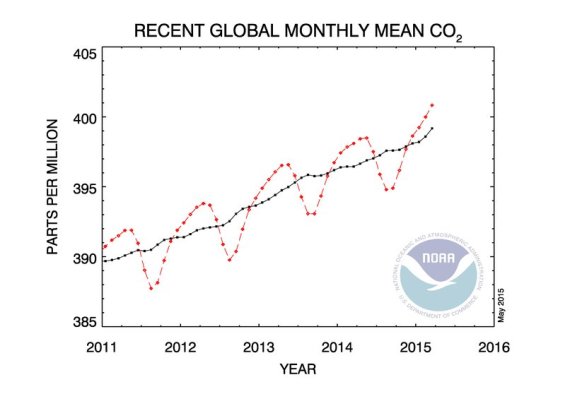“Standing on the Shores of Disaster” Global Average CO2 Exceeds 400 PPM In March
7
May, 2015
“This
may not be our climate rubicon, but we’re certainly standing on the
shores of disaster, 400 ppm is well past the point of safety which
many scientists put at 350 ppm.” Jamie Henn, co-founder and
communications director of 350.org in
an interview to Huffington Post on May 6.
*
* * *
New
reports out from NOAA today showed that in March of this year global
average CO2 levels broke the 400 parts per million monthly average
for the first time in the climate record. These levels, which include
a measure of all global readings, are the highest seen by the
inhabitants of Earth in at least three million years.
(Global
average CO2 levels exceed 400 parts per million for the first time in
March. Image source: NOAA.)
The
Mauna Loa measure, which we’ve been using for record keeping here,
first exceeded the 400 ppm threshold back in 2013, with monthly
averages hitting 401.8 ppm in May of 2014. This year, Mauna Loa daily
measures began exceeding 400 parts per million in January and have
hit as high as 404.8 parts per million in recent weeks.
Southern
Hemisphere averages lag those in the Northern Hemisphere, which
accounts for the global average delay.
This
inauspicious milestone comes with a massive burning of fossil fuels
that now dumps more than 10 billion tons of carbon (37 billion tons
of CO2 equivalent) into the atmosphere every year. It’s a
ridiculous rate of burning — likely one that is six times faster
than at any time in the deep history of Earth.
“This
marks the fact that humans burning fossil fuels have caused global
carbon dioxide concentrations to rise more than 120ppm since
pre-industrial times,” Pieter Tans, lead scientist of NOAA’s
greenhouse gas network, said in an interview to The
GuardianWednesday. “Half
of that rise has occurred since 1980.”
This
is a level far exceeding the 350 parts per million safe limit
recommended by scientists. A level that, if maintained, is enough to
warm the world by 2-3 degrees Celsius long term and cause enough ice
to destabilize and slide into the ocean to raise sea levels by 60
feet or more. And if you add in all the other greenhouse gasses, the
problem looks even worse — with about 484
parts per million of CO2 equivalent gasses circulating and trapping
heat in the Earth atmosphere.
The
problem is that once the CO2 is in the atmosphere and oceans, it
takes a long time to become sequestered. It generates extra heat for
decades, centuries and millennia. Tackling this issue not only
involves rapidly moving to a zero carbon civilization. It involves
changing the way we do business in a manner that is less disruptive
to Earth systems. In a way that allows for the carbon sinks to
vitalize and take up a portion of the massive volumes of carbon we’ve
emitted.
But
we’re nowhere near achieving that goal. Though carbon emissions
stabilized in 2014 due to rapid adoption of renewable energy sources,
continuing to emit at current rates is a recipe for disaster. What we
need is a very rapid draw down to zero emissions.
Links:
Hat
Tip to Greg




No comments:
Post a Comment
Note: only a member of this blog may post a comment.